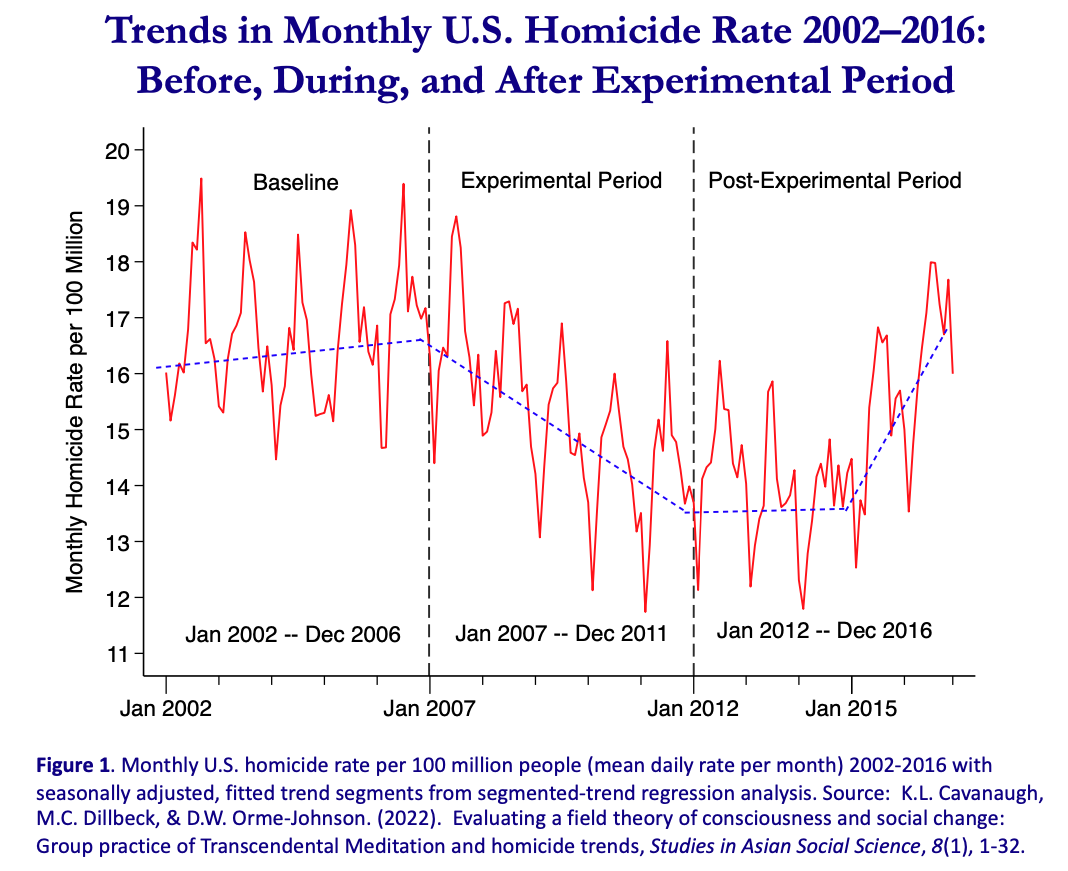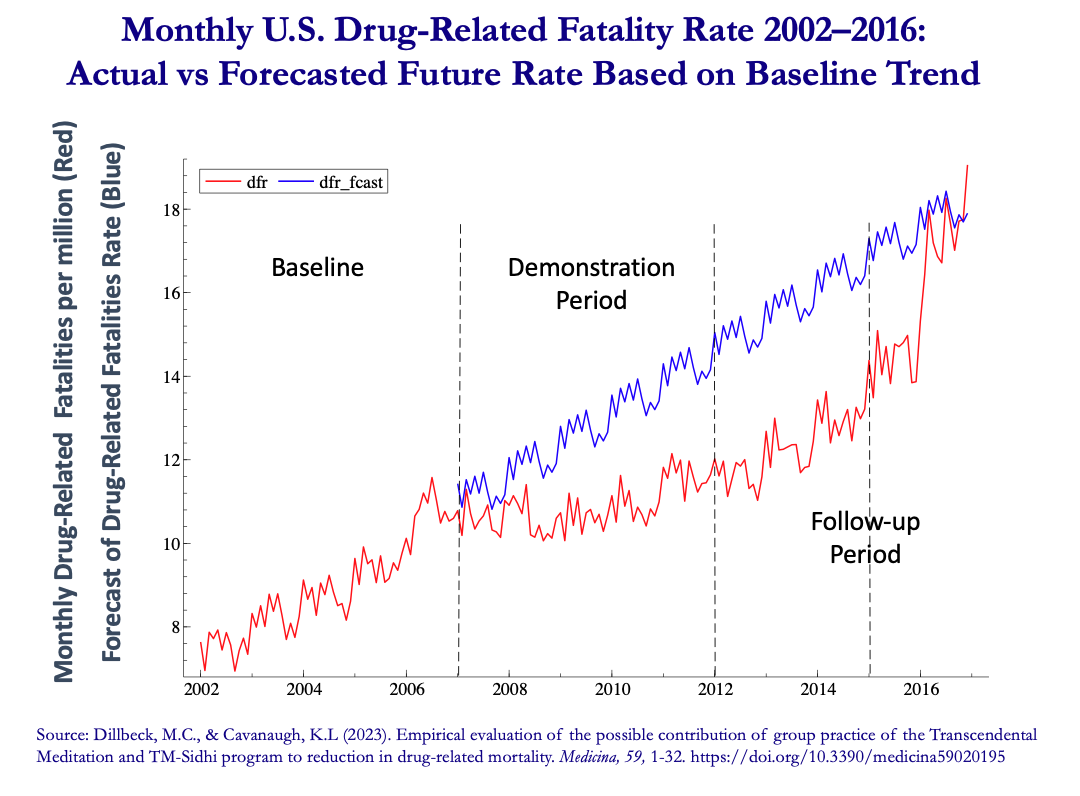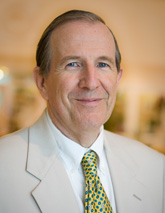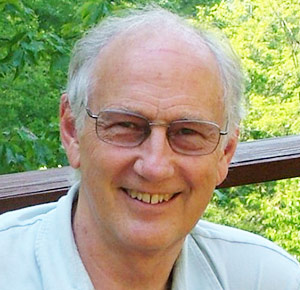
Reduced homicide and drug fatality rates — two more published studies confirm the power of the Maharishi Effect
Is it possible that groups of people sitting quietly with their eyes closed can reduce the homicide rate across the United States? Or reduce the rate at which people die from recreational drugs?
This is just what two recently published, peer-reviewed scientific studies have found, adding to the ever-growing body of evidence supporting the phenomenon known as the Maharishi Effect — the widespread positive changes that occur in society when the portion of a population practicing the Transcendental Meditation (TM) technique individually, or the TM and advanced TM-Sidhi program in groups, reaches certain thresholds.
Both studies focused on the results of a large group of TM and TM-Sidhi program experts practicing these programs twice daly in MIU”s two large Golden Domes. Between 2007 and 2010, the size of this group approached or exceeded 2,000 people, or roughly the square root of 1% of the US population — the size necessary, theoretically, to create a “tipping point,” measurably reversing negative trends.
Before 2007, both the homicide rate and drug fatality rate had been increasing. But during this four-year period, the homicide rate nationwide dropped almost 20%, or about 27,369 fewer deaths during the study period.

Similarly, the drug fatality rate plummeted more than 35%, or 86,309 fewer drug-related deaths.

After 2010, as funding for the group declined, so did the size of the group, falling below the critical threshold. After this happened, the homicide rate and the drug fatality rate both began increasing, slowly at first, and then drastically, as both charts show.
These findings raise questions.
Where did the data come from?
As in all the research studies on the Maharishi Effect, the data came from publicly available statistics.
Could something else have caused these results?
No other factor could explain the dramatic declines revealed in the statistics.
Many social forces contribute to the homicide and drug fatality rates. Homicide rates, for example, can be influenced by changes in the economy, community policing, community demographics, incarceration rates, even changes in temperature. The drug fatality rate can also be affected by changes in the economy, temperature, and opioid prescription rates. Pre-existing trends might also have had an influence.
But advanced statistical tools enable scientists to isolate the effects of these other factors and determine what influence, if any, they had on the homicide and drug fatality rates, and no other variable exerted a significant influence.
Could these results have been due to chance?
The odds that the drop in homicide rate happened randomly were less than one in ten billion, according to statistical analysis. For drug fatalities, it was less than one in one billion. In other words, the chances that these effects happened purely on their own were practically zero.
This analysis gives strong confidence that the observed results were due to the TM and TM-Sidhi program group in Iowa.
How is this possible?
In the theory behind the Maharishi Effect, a single all-pervading unified field of consciousness underlies all of nature, and human beings have access to this field in their own silent awareness. When people experience this field through their Transcendental Meditation practice, they “enliven” it.
Because the unified field is immaterial and all-pervading, unbound by space and time, enlivening this field anywhere enlivens it everywhere — nothing is excluded from this effect. Stimulating pure consciousness through TM and TM-Sidhi program practice radiates an influence of coherence and harmony, reverberating far beyond the confines of the individual mind and body.
Maharishi had predicted the effect as early as 1960, provided the specific meditation techniques to bring it about, and encouraged scientific research on it. Now 50 experiments and 28 peer-reviewed published studies corroborate the phenomenon.
The problem is worsening
Drug fatalities are currently skyrocketing in the US. According to the CDC, drug deaths rose to more than 100,000 per year in 2021 — an increase of 28.5% over the prior year. (By comparison, 55,000 people died in the entire Vietnam war over ten years.) And drugs have been the leading cause of death for young Americans since 2019.
This is largely due to the pernicious spread of fentanyl in this country, fueled by China’s illicit manufacture and distribution network. Fentanyl, 50 to 100 times more potent than morphine, is an inexpensive way to increase the power of the drugs it is combined with; unsuspecting users then ingest it via recreational drugs or painkillers.

Fentanyl became an issue only after 2010, when the size of the group declined, says Dr. Ken Cavanaugh, one of the authors of the studies and professor emeritus of applied statistics at MIU. But it’s precisely because of that decline, he argues, that the US became vulnerable to such an epidemic.
“Everywhere you look — homicide rate, the crime rate — all these indicators of social stress have escalated unbelievably since that time,” Cavanaugh said. “That’s what happens when people’s behavior is no longer being influenced by that coherence being generated from the meditation group. Their whole behavior changes, their whole way of thinking, their whole level of suffering.”
Convincing governments to provide support
The aim of this research is simple, Cavanaugh explains— to use empirical evidence to convince governments of the urgent societal demand for the TM Sidhi program.
“We want to convince governments to provide support for these programs,” he says. “To do that, you have to convince the scientists who governments rely on for advice.”
Though this has proven to be an uphill battle, Dr. Cavanaugh remains unfazed. He understands the gradual nature of scientific progress and how difficult it is for science to shift to a completely new paradigm.
“Probably 99% of scientists out there fall into the physicalist or materialist paradigm,” he says, referring to the belief that inert matter is the basic stuff of the universe. “Maharishi’s perspective, the Vedic perspective, is that consciousness is fundamental, not matter. We’re now shifting to a radically different paradigm. When you’re doing research in a new paradigm, it’s viewed as unscientific or worthless by those who adhere to the old paradigm. So it just has to be explained as clearly as possible, and people have to be open to hearing it.”
“This is such a fantastic scientific discovery”

One of the investigators in the homicide study was David Orme-Johnson, who has conducted many pioneering studies on the Maharishi Effect as well as on the Transcendental Meditation technique itself.
“What are considered the greatest scientific discoveries of all time?” Dr. Orme-Johnson asks. “Gravity, electricity, the theory of evolution, the theory of relativity, Big Bang theory, and so on. All of these things have been fantastic in giving humanity the ability to do more, be healthier, and understand nature more deeply.
“But in my opinion, there is nothing as great as this simple discovery, the Maharishi Effect, this simple thing that can change everything, almost overnight, in a positive direction. This is such a fantastic scientific discovery.”
REFERENCES
The study on homicide rates, entitled “Evaluating a Field Theory of Consciousness and Social Change: Group Practice of Transcendental Meditation and Homicide Trends,” was published in August 2022 in the journal Studies in Asian Social Science and authored by the research team of Kenneth Cavanaugh, Michael Dillbeck, David W. Orme-Johnson.
The study on drug fatality rates, “Empirical Evaluation of the Possible Contribution of Group Practice of the Transcendental Meditation and TM-Sidhi Program to Reduction in Drug-Related Mortality,” was published in the journal Medicina and was authored by Dillbeck and Cavanaugh.
Cavanaugh is professor emeritus of applied statistics at MIU, Orme-Johnson is past chair of the MIU department of psychology, and Dillbeck is past professor of psychology and a member of the MIU Board of Trustees.
